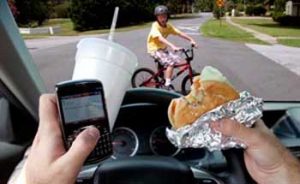Words have power, and the distinction between an “accident” and a “crash” may be one of the most overlooked examples. The National Institutes of Health has endorsed this change, as have a number of other governmental and scientific groups. A word like accident implies an inevitable incident that no one could prevent. But trains derail, ships sink, and planes crash. According to many, vehicle collisions should have the same status. After all, in the 1980s, drunk drivers often said “it was an accident” after they caused fatal collisions.
To be sure, some vehicle collisions are accidents. Lightning strikes and sudden wind gusts cause a handful of collisions each year. But the vast majority of these incidents involve some kind of driver fault. The fault often involves one of the five types of driving impairment, as identified by the National Highway Traffic Safety Administration.
Most all car crash victims are entitled to economic damages, for things like medical bills. Compensatory damages normally also include money for pain and suffering, loss of enjoyment in life, emotional distress, and other noneconomic damages.
Many extreme impairment cases also involve punitive damages. These additional damages are available if the tortfeasor (negligent driver) intentionally disregarded a known risk. Some examples include a tortfeasor with an extremely high BAC, a tortfeasor who knows she is extremely fatigued, and a tortfeasor who knows he has a disabling medical condition. To obtain these damages, the victim/plaintiff must introduce clear and convincing evidence of extreme recklessness.
Alcohol
For a number of years, decisionmakers have tried to stem the tide of alcohol-related car crashes. But seemingly nothing has worked. Alcohol is still a factor in almost a third of the fatal car crashes in Georgia. The proportion is usually even higher in suburban and semi-rural areas, like the ones that dominate many states in the South.
Alcohol’s availability may make it the most dangerous and widespread form of impairment. Anyone over 21 can purchase and use alcohol at almost any place and at almost any time.
This substance impairs motor skills. Alcohol also replaces sound judgement with a sense of euphoria. When operating heavy machinery, like a vehicle, both these brain functions need to be functioning at their optimal levels.
As mentioned, the injuries in alcohol-related crashes are often very serious. They often involve wounds that are unique to car crash cases and difficult for other physicians to diagnose and treat.
Drugs
In many areas, there may be more “drugged drivers” than drunk drivers. Many substances have an adverse effect on the mind and body, including:
- Street drugs, like heroin or crack,
- Prescription drugs, like Xanax or Oxycontin, and
- Over-the-counter drugs, like Sominex or Nyquil.
Note that even if the tortfeasor purchased and used the drug legally, it’s still dangerous and illegal to drive under the influence of the substance.
Establishing liability for drugged driving crashes is a bit more difficult than establishing liability in drunk driving cases. There is no Breathalyzer test for drugs. Law enforcement officers may perform blood or other tests, but these tests are rare except in fatal injury cases. So, in court, victims may use circumstantial evidence to prove negligence. Such evidence includes empty pill bottles, current prescriptions, and physical characteristics like bloodshot eyes or unsteady balance.
Fatigue
Alcohol and drowsiness affect the brain in about the same way. Driving after eighteen consecutive awake hours is like driving with a .08 BAC. Also, just like there is no cure for intoxication except time, there is no fix for fatigue except sleep. Old tricks like playing the radio or rolling down the window do not work.
Once again, victims may use circumstantial evidence to establish drowsiness. The amount of rest the tortfeasor had the night before is obviously relevant. Additionally, most people are normally drowsy at certain times of the day or night, no matter how much rest they had the night before.
In large vehicle collisions, direct evidence may be available. Most semi-trucks have Electronic Logging Devices. These gadgets provide positive proof of working hours and resting hours.
Distraction
Alcohol, drowsiness, and drugs all have both mental and physical effects on drivers. The same is true of distraction, and hand-held cell phones are a good example. These devices combine all three kinds of distracted driving, which are:
- Manual (hand off the wheel),
- Visual (eyes off the road), and
- Cognitive (mind on something other than driving).
Hands-free cell phones may not be much better. In fact, according to some researchers, these devices may be even worse. People who operated hands-free devices are still visually and cognitively distracted. Plus, these gadgets give many drivers a false sense of security.
There are other forms of distracted driving as well. Something like eating while driving involves all three types of distraction, as does drinking while driving, reading while driving, or applying makeup while driving. Jurors may characterize a few incidents, such as rolling down the window, as one-off accidents. But nearly all forms of distracted driving involve a lack of reasonable care, which is the essence of a negligence claim.
Medical Condition
A number of chronic conditions, such as epilepsy and heart disease, may cause sudden and unexpected loss of consciousness. When that occurs, dangerous loss-of-control collisions usually result. When a vehicle goes out of control, it may strike pedestrians on the sidewalk or go across the center line and hit another vehicle head-on.
Most states suspend the drivers’ licenses of people with specified conditions. But these safety suspensions usually only last a few months, even if the driver has a chronic illness. Furthermore, the state takes no action at all unless it receives a report. So, many people with dangerous medical conditions have valid drivers’ licenses.
Impaired drivers often cause serious injuries that only an experienced car crash physician can diagnose and treat properly. Call us today to start down the road to recovery. We work closely with most injury attorneys in most jurisdictions.


